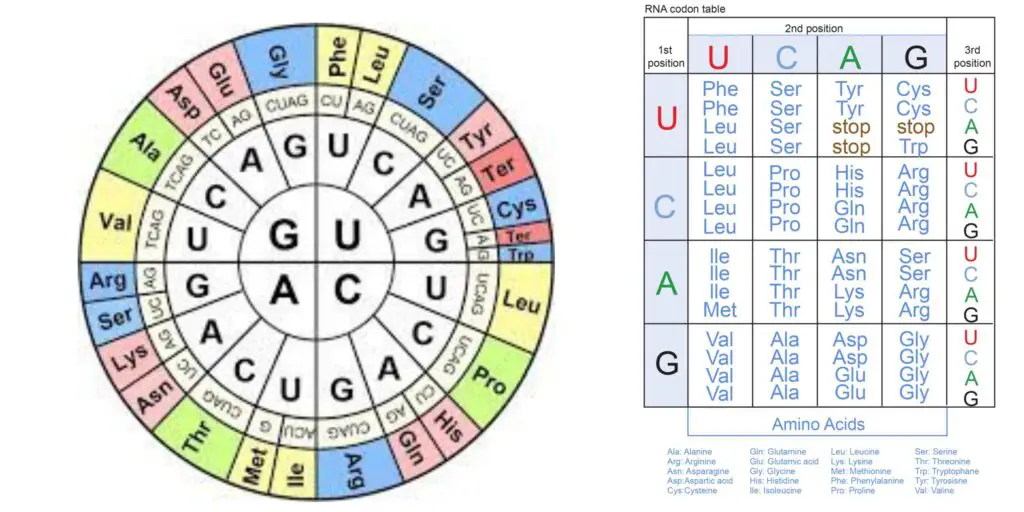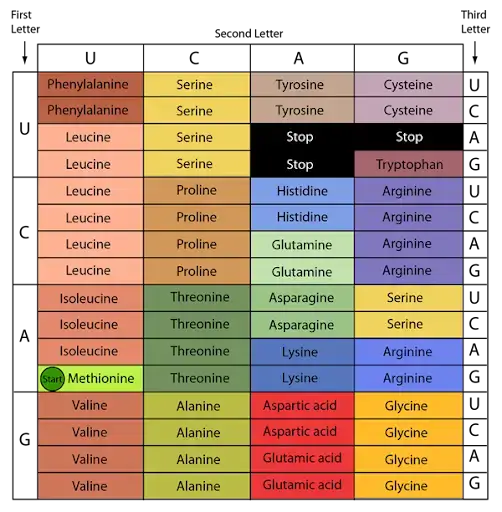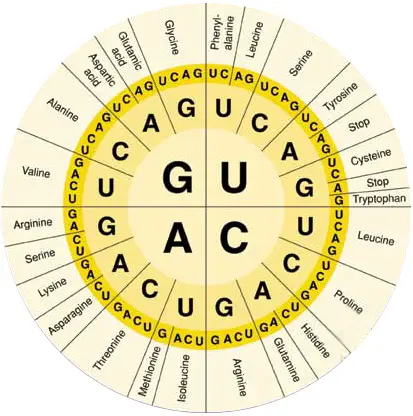Genetic code refers to the rules which the linear nucleotide sequence identifies what is the linear structure of the polypeptide. This means that they define what sequences of nucleotides in an mRNA transformed to the amino acid sequence in the polypeptide. This is why the relationship with the nucleotide sequence in your mRNA, and that of an amino acid sequence in the polypeptide constitutes. The nucleotide sequence can be encoded as codons or triplets.
Principles Of The Genetic Code
The genetic code is composed of 64 codons that are different each codon encodes one among the 20 amino acids. A codon is three nucleotide bases.

Characteristic of Genetic Code
The genetic code comes with numerous unique characteristics that have been proven by solid experimental proofs.

A. Triplet nature
Doublet and singlet codes are not sufficient to encode 20 amino acids. Hence it was suggested that triplet codes are the minimum code needed.
B. Degeneracy
This code can be described as degenerate. This implies that the same amino acid can be encoded by multiple triplets of base. This does not mean that there is a that there is no specificity in the process of protein synthesizing. It is simply a sign that an amino acid may be placed within the peptide chain via multiple base triplets. For instance three amino acids of arginine leucine, and alanine contain six codons that are synonymous. Codon degeneracy is composed of two kinds that are partial and complete. In partial degeneracy the first two nucleotides are the same, but the 3rd (i.e. 3 bases) nucleotide in the codon of degenerate is different; for instance, CUU and CUC code for leucine. Complete degeneracy is when any of the four bases may be in third position but encode for an amino acid of the same type, for instance, UCU, UCC, UCA and UCG all code for serine.
C. Non-overlapping
Genetic codes are nonoverlapping i.e.,the codons that are adjacent do not overlap. A nonoverlapping code indicates that the exact same word can’t be utilized for two codons. That is, a single base is able to take part in the creation that contains two codons.
D. Commaless
Genetic code composed of commaless (or”comma-free”). There is no indication to signify the beginning of one codon, or the beginning of the following. There aren’t any intermediary nucleotides (or commas) between codons.
E. Non-ambiguity
Non-ambiguous code implies that there is no confusion regarding a specific codon. A specific codon will code for the identical amino acid. Although an amino acid could be encoded by multiple codons (the codon code can be degenerate) however, the one codon will not code for more than two distinct amino acids (non-ambiguous).
F. Universality
The universality of the code implies that the exact sequences of three bases encode the same amino acids across every living thing from basic microorganisms to complicated multicelled organisms like humans. The code was developed based on studies done by the bacteria Escherichia coli, it is applicable to all other organisms. The genetic code can be applied for all living organisms, with some minor variations, such as yeast, mitochondria, as well as the Mycoplasma.
G. Polarity
The genetic code exhibits polarity and polarity, which means that the code is read in a specific orientation, i.e., in the 5′ → 3′ direction. It is clear that , if the genetic code was read in a different direction (i.e., 3′ → 5′), it would identify two different proteins, as the codon would be reversed the base sequence.

Special Codons
A. Chain Initiation Codons
Triplets AUG and GUG are double-duty within E. coli. When they occur between the 2 ends the Cistron (intermediate position) they encode the amino acids methionine and vanline at an intermediate position of the protein structure. However, if they occur following a terminator codon they serve like “chain initiation” (C.I.) signs also known as “starter codons” for the creation of polypeptide chains.
B. Chain Termination Codons
The three triplets UAA, UAG, UGA are not coded with any amino acid. If one of them occurs before the triplets GUG or AUG and GUG, it triggers the dissociation in the chain of polypeptides from the ribosome. They are also known”stop codons. They are also referred to as chain termination codons due to the fact that they are utilized by cells to signal the conclusion of the translation process of a specific peptidyl chain. However their inclusion within any mRNA leads to abruptly ending any message that is sent at the time of their position, even though the polypeptide chain still has not been fully completed.
C. Sense Codons
The 61 codons that code for specific amino acids, are known”sense codons.
D. Non-Sense Codons
Triplets UAA, UAG, UGA are not encoded for amino acids of any kind. They were initially classified by the term “non-sense codons. But, the so-called “non-sense” codons have been discovered as belonging to “special sense”. Special-sense codons serve the purpose of punctuating genetic information as a complete stop at the end of the sentence.
Mutations of Genetic Codes
Every person is unique. In fact it has been found that a specific physiological feature disappears. This happens because the genetic codes are changed and deleted in replication and transcription. Different DNA segments get rearranged and deleted in the process, leading to changes.
Genes are acquired and destroyed during the process, which results in new physical traits for an organism. Let’s consider an instance. When Valine (Val) occurs to be substituted with Glutamine (Gln) inside the sequence of a specific gene the patient will develop sickle cell anemia. This is a blood disorder.
In conclusion, the gene code for an animal relies on the genes that are inherited from the parents and how it is generated through transcription and replication. We’ve learned about how bases are codons, and also how they control the creation of amino acids. They are the units of protein that make up the genetic material in an organism, following a specific sequence. Based on the information above students can create the genetic code PPT and test their comprehension the genetic code.
Patterns Of The Genetic Code
- Amino acid with similar structural characteristics tend to be related codons.
- Codons of aspartic acid (GAU, GAC) are identical to glutamic acid codons (GAA, GAG); The difference is evident only within the middle base (toward the 3′-end).
- Similar to the codons of those amino acids with aromatic properties Phenylalanine (UUU, UUC), the amino acids tyrosine (UAU, UAC) and tryptophan (UGG) all start with the letter uracil (U).
- All codons that have U at the 2nd position are Hydrophobic amino acids (Ile, Leu, Met, Phe, Val).
- All codons that contain An in the first place indicate the amino acids that are charged with the exception of the Arg.
- All acidic (Asp, and Glu) as well as the basic (Arg Lys, Asp) amino acids contain A or G as the second base.
What is Reading Frames And Open Reading Frames?
The mRNA sequence is taken up by the ribosome into three different reading frames. Most of the time, only one of the reading frames contains a functional protein as the two other reading frames have multiple codons that terminate. In some bacteriophages the overlapping genes are present that make use of distinct reading frames. A reading frame that is open (ORF) refers to a set of codons which begins with ATG and finishes with a codon that terminates, TGA, TAA or TAG.
Coding regions of genes have rather long ORFs, unlike non-coding DNA in which ORFs are typically short. The presence of an open reading frame within DNA sequences could be a sign of the existence of a codon region. A computer examination of ORF could be utilized to determine the sequence of encoded protein.

- Text Highlighting: Select any text in the post content to highlight it
- Text Annotation: Select text and add comments with annotations
- Comment Management: Edit or delete your own comments
- Highlight Management: Remove your own highlights
How to use: Simply select any text in the post content above, and you'll see annotation options. Login here or create an account to get started.